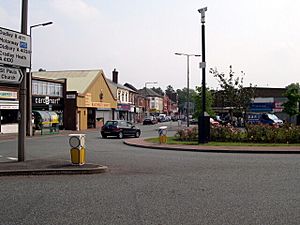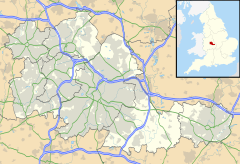Blackheath, West Midlands facts for kids
Quick facts for kids Blackheath |
|
|---|---|
 Blackheath Marketplace |
|
| Population | 12,292 (2011) |
| OS grid reference | SO9786 |
| Metropolitan borough |
|
| Shire county |
|
| Metropolitan county | |
| Region | |
| Country | England |
| Sovereign state | United Kingdom |
| Post town | ROWLEY REGIS |
| Postcode district | B65 |
| Dialling code | 0121 |
| Police | West Midlands |
| Fire | West Midlands |
| Ambulance | West Midlands |
| EU Parliament | West Midlands |
| UK Parliament |
|
Blackheath is a town in England. It is located in the Sandwell Metropolitan Borough, which is part of the West Midlands region.
Contents
Discovering Blackheath's Past
Before 1841, Blackheath was known as Bleak Heath or Blake Heath. It was a small area with just a few farmhouses and inns. These buildings were located along a main road that connected Oldbury to Halesowen. This area was part of Rowley Regis.
How Blackheath Grew
The Industrial Revolution brought big changes to England. In 1841, a special law allowed land in Rowley Regis to be sold. This money helped build a new church house. Developers bought this land.
Throughout the rest of the 1800s, these developers helped Blackheath grow. It became a town where people lived, especially those working in nearby industries. Many people worked in the coal mine at Coombes Wood. Others worked at the Hailstone quarry. Workers moved to Blackheath from all over England and especially from Wales. Soon, Blackheath and its nearby towns grew together. They became part of the larger city area around Birmingham.
Churches and Faith
The area of St Paul became its own church parish in 1865. A new church was officially opened in 1869. Blackheath has also had a long history of nonconformist churches. Many Methodist and Baptist chapels were built there.
Industry, Trains, and Progress
A market was set up in Blackheath. A new part of the Great Western Railway opened in 1867. This train line connected Birmingham and Worcester. It also included a train station in Blackheath.
Factories and Mines
Into the 1900s, more factories started operating. The mining industry began to shrink. The last coal mine in the area closed in 1919. Big companies like Thomas William Lench, which made fasteners, and British Thomson-Houston (BTH), an electrical engineering company, became major employers.
Manufacturing remained the main way people earned money until the early 2000s. The BTH factory kept running. Over the years, it was known by different names. These included AEI, GEC, GEC-ALSTHOM, Hawker Siddeley, BTR, and Electrodrives.
Local Government Changes
Blackheath was part of the area called Rowley Regis until 1966. After that, it became part of Warley. Since 1974, Blackheath has been part of the Sandwell metropolitan borough.
Historically, Blackheath was part of Staffordshire. In 1966, the boundaries changed. The new area of Warley became part of Worcestershire. Since 1974, Blackheath has been part of the West Midlands metropolitan county.
Blackheath's Economy
Blackheath has always been a place where many working-class families lived. The homes were usually modest. The town faced tough times in the 1970s and early 1980s. Many people lost their jobs.
However, things got better in the 1990s. Homes improved, and new stores opened in the town centre. The road network also got better. A large J Sainsbury supermarket opened in the town centre around this time.
Blackheath has many ways to travel. Buses go throughout the area. The Rowley Regis railway station is also nearby.
More About Blackheath
Blackheath Primary School is located in the area. It was first built in the late 1800s. It had a school for young children (ages 5-7) and a junior school (ages 7-11). Later, a nursery for 3 and 4-year-olds was added. In September 1990, these schools joined to form Blackheath Primary School. In September 2005, the school moved to a new site. This site was previously used by Britannia High School.
A football team called Blackheath Town F.C. used to play in a local league. Now, they focus on training young players.
Improving Traffic Flow
After the Second World War, more cars were on the roads. Blackheath became a place where traffic often got stuck. Things got a little better in the late 1970s. A new road was built around the north side of the town centre. But this only helped traffic coming from Cradley Heath and Brierley Hill.
Drivers coming from Quinton still had to use the old, narrow roads. This problem was fixed in 2006. A new relief road was built. It goes around the eastern part of the town centre. This road helps traffic from Halesowen, Quinton, and Oldbury avoid the busy centre.
Blackheath has strong public transport links in the Black Country. You can take direct buses and trains to Birmingham. The large bus network also connects locals directly to Oldbury, Halesowen, Dudley, Cradley Heath, West Bromwich, Wolverhampton, Merry Hill Shopping Centre, and Walsall.
Famous People From Blackheath
- Tommy Smart was a professional footballer. He played for the England team and Aston Villa.
- Glenn Tipton is a guitarist for the band Judas Priest. He was born in Blackheath in 1947.
- Samuel Page was a professional football goalkeeper around 1925.
See also
 In Spanish: Blackheath (Midlands Occidentales) para niños
In Spanish: Blackheath (Midlands Occidentales) para niños


